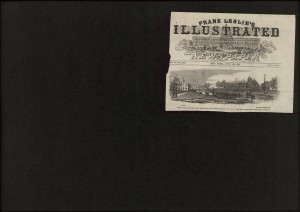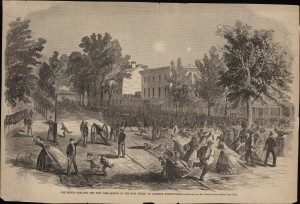I came to the archives this afternoon with the intention of searching through letters, getting leads from letters, and then following those leads through to more letters, documents, ect., which will probably happen after this post.
I went to the card catalogue with the intention of looking up H.M. Johnson, who was the president of the college at this time. Since the J drawer was missing, I went to the drawer labeled ‘Carlisle’ just to see what was there. I ended up coming across 3 images that deal with the invasion of Carlisle. Each can be found under the title of the image in the Dickinson College Archives card catalogue in the drawer labeled ‘Carlisle’.
The first is a sketch donated by Boyd Waidner-Spahr to the library. It depicts the shelling of the New York Militia by the rebel guns on the main street of Carlisle. The archives date it as being from July 1, 1863.
“The rebels shelling the New York Militia in the main street of Carlisle, Pennsylvania. Sketched by Mr. Thomas Nast.”
- courtesy of Dickinson College Archvies
The second image I came across was a woodcut from Frank Leslie’s Illustrated Newspaper, dated July 18, 1863. The image depicts the burning of the Carlisle Barracks by rebel forces, and was created by the artist George Law, who was employed by the newspaper.

courtesy of Dickinson College Archives
The final image I came across was a broadside announcement dated July 3, 1863. It is a call to arms for the citizens of the Cumberland Valley. The flyer denounces the rebels as “ruthless invaders” “not satisfied with revolt, rebellion, and treason at home, the misguided men that have sought to tear down our government and destroy our democratic institutions.” The flyer ends with the words, “circulate through the county.”
My final thoughts on these images is that they were designed to serve a purpose, namely as propaganda against the rebel army. While the flyer is obvious, the woodcut and the sketch are somewhat more subtle due to the fact that don’t outright state their intentions. Instead, they allow the depiction of fallen Union soldiers and burning Union military buildings arouse the patriotic flames within those who may join the Union army.
I’d like to end with a gracious thank you to the secretary of the Archives. She’s a lovely woman, and very helpful. I’m sure she’ll be more helpful to me yet.



Well done post, but please go back and make sure that you clearly indicate where these images are located. Specify the drop file or collection where another researcher could obtain them.
Also, could you go ahead and make this post public?
I will make this public tomorrow professor. I want to go back to the archives and get the titles of the images, because for some reason, although I entitled the images with the titles they were under in the archives when I uploaded them, I can’t seem to find them now. That will also additionally clarify finding them in the archives.